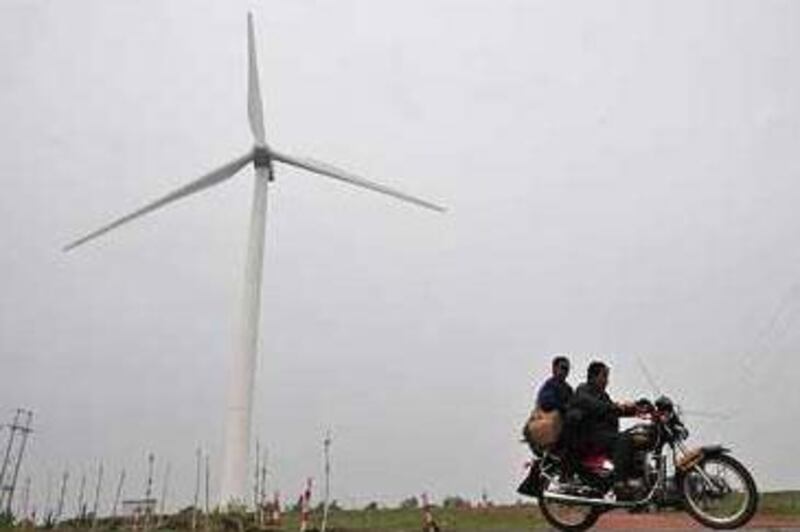China's image may be that of a major polluter and its heavy reliance on coal-fired power means it is up there with the US as the world's top producers of carbon dioxide. But the country is also at the forefront of introducing renewable energy products and has bold ambitions to improve its environmental record. The world's most populous nation is on a major drive to boost renewable energies and cut pollution for pragmatic reasons, and the central government is paying for most of China's efforts to go green. China is the world's second-largest consumer of oil, behind the US, but oil prices are too volatile and the government wants alternative energies to reduce China's dependence on it. Coal, which provides 70 per cent of China's energy needs, is not going to last forever and also has unpredictable prices. Then there are political concerns. People in the highly polluted cities such as Linfen and Tianying often complain that their children have nowhere to go to escape the bad air, and that they are worried about their health. "In recent years, China's economy has developed very fast but it relies heavily on coal, which has had severe consequences for the environment," says Yang Ailun, Greenpeace China's climate and energy campaign manager. "China has realised its dependency on coal is not sustainable so China is willing to invest in renewable energies that could provide energy security, so as to ensure our economy's development. I believe China has the potential to become the world's superpower in renewable energy use and energy efficiency." Even though China's per capita carbon dioxide emissions were about only a fifth of those in the US, its population of 1.3 billion and rapidly growing economy means the country has overtaken America as the largest emitter. Every week to 10 days another coal-fired power plant opens somewhere in China. According to the World Health Organisation, China had 16 of the world's 20 most polluted cities in 2007, and other urban centres such as Hong Kong have suffered from its factory smoke stacks. In 2006 the government passed the China Renewable Energy Law and in 2007 it released a mid-to-long-term renewable energy plan that aims to have 15 per cent of China's energy come from renewable sources by 2020. Li Keqiang, the vice premier, said in May the new energy industry that included energy consumption and environmental protection was a "strategic industry", meaning it had strong blessing from the central government. Liu Qi, the deputy director of the National Energy Administration, believes new energy output was likely to exceed the targets set by the nation's overall energy plan and renewable energy plan. Some officials have said the target could be raised to 20 per cent. "We are aiming to make the new energy industry a new engine of development," says Mr Liu, who worked on a plan for a strategic shift to nuclear, solar, wind, bio-mass power and clean coal technologies, with investment opportunities worth as much as 3 trillion yuan (Dh1.61tn). The central government recently revised the wind target from 30 gigawatts to 150gw of generating capacity by 2020. A big driver behind China's green energy market has been the government's 4tn yuan stimulus package, part of which is dedicated to renewable energy products such as solar water heaters. China is the biggest user and producer of solar water heaters in the world, accounting for more than half of the world's total. The country accounts for nearly 80 per cent of the world's market for these kind of products. To illustrate the country's green push, China is the world's fourth-largest wind power producer, and the last four years wind power installation capacity has doubled every year. China will surpass the US as the biggest wind turbine market this year and Beijing recently launched a project in Gansu Province called the "Three Gorges on Land". This development will equal the generating capacity of the 22gw Three Gorges Dam. New green energy projects are announced almost daily and many are launched by private initiatives. The listed solar power group Suntech Power Holdings recently entered a strategic agreement with China Huadian New Energy Development to develop a total of 500 megawatts of utility scale and commercial rooftop solar projects in Jiangsu and Shanghai provinces in the next three years. China Wind Systems has signed a 95.6 million yuan contract to supply wind tower flanges to Chengxi Shipyard. China Biodiesel has announced trial production at its new plant in Xiamen, in Fujian Province, that will double the company's annual production capacity to 100,000 tonnes, nearly four times last year's output. Mr Yang says China's recent development in renewable energy is "very promising". "China has already become the world's fourth largest wind power producer," he says. "Every two hours a new wind power machine is produced. In the last four years wind capacity has doubled every year. China's renewable energy development is really fast."
China takes lead in green race
World China is at the forefront of introducing renewable energy products and has bold ambitions to improve its environmental record.

Editor's picks
More from the national




